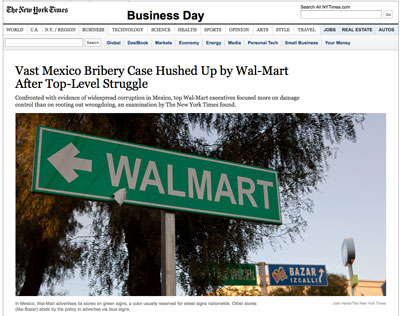David Barstow, a Pulitzer Prize-winning investigative reporter for the New York Times, spent 10 months tracking a paper trail to determine what Wal-Mart executives knew about bribery allegations in its Mexico operations.
Thousands of pages and interviews later, he gave readers a chronological look at what happened. For that, he was named Gold winner in this year’s Barlett & Steele Awards for Investigative Business Journalism.
The story started with a handful of documents about the Mexico operations, David says. “It was too intriguing to ignore,” he says. “I wanted to put together the pieces of what happened.”
His mission became finding out what happened in Mexico and what happened at Wal-Mart’s headquarters in Bentonville, Ark., he says. But he had to get over a few things first.
He’d never written about the company and needed to learn about it, its executives and how the Mexico unit fit into the company, he says. “It was a steep learning curve,” he says.
Also, he didn’t speak Spanish. He had to rely on translators and stringer Alejandra Xanic von Bertrab, especially during his 10 trips to Mexico. “It’s always a daunting thing when you take on a company operation in faraway places,” he says.
But the biggest hurdle was getting around confidentiality restrictions to get the paperwork he needed to prove Wal-Mart knew about the $24 million in bribery payments for zoning rulings and construction permits in Mexico. That wasn’t going to happen with phone calls and emails, he says. So he went to people’s homes and knocked on doors.
He developed a plan for approaching people in a certain order to build on what he already knew. “You have to do your homework to persuade them you’re not on a fishing expedition, but you’re serious about the work you’re doing and you already made progress.”
Mexico’s open records laws, something many reporters probably wouldn’t know existed, enabled him to get thousands of documents related to permits. David says many countries are adopting better transparency laws. “It creates more records to track corruption in far off corners of the world,” he says.
David says he chronologically arranged key events to organize the information. When he was done, he had 200 pages.
One question I’ve asked all of this year’s winners is how they stay focused on these lengthy projects.
“The mindset has to be ‘I’m trying to say something and, in order to say those things, I need tons of facts and I need to gather them brick by brick,’” he says.
David likens investigative projects to marathons. He creates “sprints” by breaking the process into a series of questions to answer, challenging himself to figure out something everyday. He also brings his editors “into the hunt” for support.
“The most difficult thing is carrying the burden of a story for so long,” David says. “It’s definitely a journey. The most miserable thing sometimes is having your mom and dad wondering why you haven’t been in the paper for a while.”










